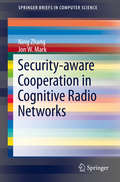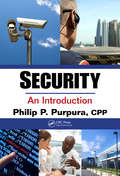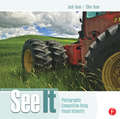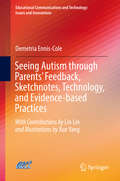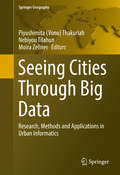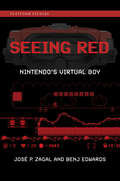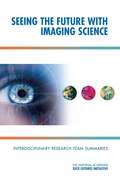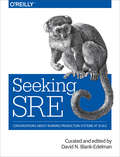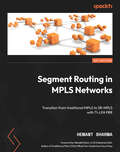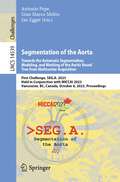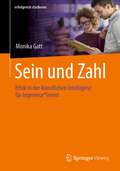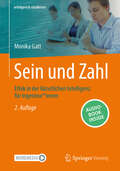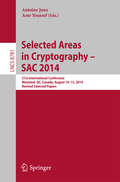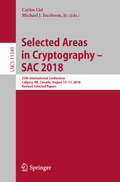- Table View
- List View
Security-aware Cooperation in Cognitive Radio Networks
by Ning Zhang Jon W. MarkThis brief investigates spectrum efficient and energy efficient strategies, known as cognitive radio networks (CRNs), to ensure secure cooperation between licensed and unlicensed users. The authors address issues of spectrum scarcity, spectrum sensing, transmission performance, trust-aware cooperation, and secure communications. Two security-aware cooperation based spectrum access schemes are presented. The first is a trust-aware cooperative framework for CRNs to improve the throughput or energy efficiency of licensed users and offer transmission opportunities to unlicensed users, taking into consideration the trustworthiness of unlicensed users. The second scheme is a cooperative framework to enhance secure communications of licensed users. An introduction to CRNs and literature survey enhance the discussion while numerical results are provided to demonstrate the viability of the proposed schemes. The brief is designed for researchers and professionals working with cognitive radio networks or interested in cooperation based access. Advanced-level students studying computer communication networks and communications engineering will also find this brief useful.
Security: An Introduction
by Philip P. PurpuraToday, threats to the security of an organization can come from a variety of sources- from outside espionage to disgruntled employees and internet risks to utility failure. Reflecting the diverse and specialized nature of the security industry, Security: An Introduction provides an up-to-date treatment of a topic that has become increasingly comple
Seduce Me: A Stark Ever After Novella (Stark Series #18)
by J. KennerNew York Times bestselling author J. Kenner continues her beloved Stark series with a scorching-hot Stark Ever After novella for Nikki and Damien Stark as they make an impromptu getaway to Las Vegas. For fans of Fifty Shades of Grey, Sylvia Day, Meredith Wild and Jodi Ellen Malpas. There's no better place to turn up the heat than in Sin City...I've never felt as close to anyone as I have with Damien Stark. I know every line of his body, every secret within his soul. There's nothing I crave more than his touch, and with his kiss, he seals his claim.Las Vegas is the perfect place for us, where we can indulge every desire and fantasy. But when someone from my past resurfaces, I can't ignore my instinct that I have to make things right.With Damien by my side, I feel safe no matter the danger. Our passion protects us, drives us, makes us whole. His pleasure is an exquisite game, and one that I'll play forever.Find out how it all began for Damien and Nikki in J. Kenner's hot and addictive bestselling Stark series: Release Me, Claim Me, Complete Me, Take Me, Have Me and Play My Game.Return to the smoking hot Stark world with the Stark International trilogy: Say My Name, On My Knees and Under My Skin is the explosively emotional story of Jackson Steele and Sylvia Brooks.Don't miss J. Kenner's sizzling Most Wanted series of three enigmatic and powerful men, and the striking women who can bring them to their knees: Wanted, Heated and Ignited.***SEDUCE ME was previously published for a limited time in the SWEET SEDUCTION anthology***
See It: Photographic Composition Using Visual Intensity
by Josh Anon Ellen AnonA good image is more than just acceptable exposure and sharp focus -- two components that photography instruction concentrates on. A fascinating subject doesn't necessarily result in a good image, and likewise, it's possible to create an outstanding image of a mundane subject. So how do you know the difference? Perhaps you've read a lot of material on how to use your camera, how to manage images, and/or how to make adjustments using different software programs. What usually is not covered is what needs to be done beyond obvious exposure, noise, and sharpening issues so that you can intuitively recognize the difference between a good and bad image, and most importantly, why. That's where this book comes in. Rather than wasting time blindly trying one approach or another until something seems right, the quality of your imagery and the speed of your workflow will both vastly improve once you are able to articulate why you prefer one image to another. Expert authors Josh and Ellen Anon have spent years perfecting their visual-intensity based approach to composition, and in this gorgeous, full color guide, they'll share their techniques with you so that your overall photographic experience, both in terms of time investment and quality of output, will become a much more satisfying one.
See What I Mean
by Kevin ChengIf you're an executive, designer, product manager, marketer, or engineer, communication is part of your work. Using images and text in unique ways, comics can engage readers in ways traditional methods can't. In See What I Mean, you'll learn how to create comics about your products and processes without an illustrator—just like Google, eBay, and Adobe do.
See Ya Later: The World According to Arron Crascall
by Arron CrascallAlright guys? It's me, Arron. Or as some people call me, 'that guy with the phone, the skinny jeans and the really fat head'.In a world that seems to be freefalling without a parachute towards utter chaos, I'm here to remind you that when life gives you lemons, make lemonade. No, in fact, when life gives you lemons, make a fool out of yourself in the lemonade aisle.*Because there's more to life than Brexit, Bake Off and banging on about being vegan. Yes, with this book - which is my take on the world - you will learn how to survive a proper lads' holiday, become a master in the art of takeaway ordering and find out about the pitfalls of seriously inappropriate tattoos.So do yourself a favour: turn off the news, cancel that juice cleanse, open your eyes to the brilliant, hilarious world we live in and most importantly . . . buy this book.SEE YA LATER! Arron x*Actually, don't do exactly that, that's my thing.
See Yourself in Cyber: Security Careers Beyond Hacking
by Ed AdamsA one-of-a-kind discussion of how to integrate cybersecurity into every facet of your organization In See Yourself in Cyber: Security Careers Beyond Hacking, information security strategist and educator Ed Adams delivers a unique and insightful discussion of the many different ways the people in your organization—inhabiting a variety of roles not traditionally associated with cybersecurity—can contribute to improving its cybersecurity backbone. You’ll discover how developers, DevOps professionals, managers, and others can strengthen your cybersecurity. You’ll also find out how improving your firm’s diversity and inclusion can have dramatically positive effects on your team’s talent. Using the familiar analogy of the color wheel, the author explains the modern roles and responsibilities of practitioners who operate within each “slice.” He also includes: Real-world examples and case studies that demonstrate the application of the ideas discussed in the book Many interviews with established industry leaders in a variety of disciplines explaining what non-security professionals can do to improve cybersecurity Actionable strategies and specific methodologies for professionals working in several different fields interested in meeting their cybersecurity obligationsPerfect for managers, directors, executives, and other business leaders, See Yourself in Cyber: Security Careers Beyond Hacking is also an ideal resource for policymakers, regulators, and compliance professionals.
Seeing Autism through Parents’ Feedback, Sketchnotes, Technology, and Evidence-based Practices (Educational Communications and Technology: Issues and Innovations)
by Demetria Ennis-ColeSeeing Autism is a comprehensive but easy-to-understand guidebook for caretakers, parents, educators, counselors, therapists, and researchers on various aspects of rearing and supporting children with autism spectrum disorder. It provides textual and visual information on technology tools, symptoms, diagnosis, auditory, sensory, visual, physical, and educational issues, as well as strategies and practices to help children on the Autism Spectrum reach their potential. Seeing Autism uniquely capitalizes on sketchnotes, a visual thinking tool, to communicate information and practices. Sketchnotes provide a unique space that can help the reader think differently, generate a variety of ideas, explore alternatives, and develop constructive points for expressing ideas and developing visual communication aids. This book will assist parents, educators, and professionals in schools (counselors, school psychologists, librarians) who work with children diagnosed with ASD; it will help readers increase their knowledge of autism and gain an appreciation for evidence-based practices and forms of technology that can be used to support learners on the autism spectrum. “This book is a call to arms and is as much a resource for the family friend as it is for the provider coming to the home. In the book Seeing Autism, Dr. Demetria Ennis-Cole helps individuals gain an incredible perspective and learn the struggles, challenges and joys of families rearing children, teens and adults on the spectrum. This book covers the entire spectrum and is a fantastic mix of research, parent perspective, and even sketchnotes for visual learners. The material is well-balanced and is a great resource to support individuals on the spectrum at home, in the community or in the classroom." Brad McGarryFather, Speaker, Author and Director of the Autism Initiative at Mercyhurst University
Seeing Cities Through Big Data
by Piyushimita Vonu Thakuriah Nebiyou Tilahun Moira ZellnerThis book introduces the latest thinking on the use of Big Data in the context of urban systems, including research and insights on human behavior, urban dynamics, resource use, sustainability and spatial disparities, where it promises improved planning, management and governance in the urban sectors (e. g. , transportation, energy, smart cities, crime, housing, urban and regional economies, public health, public engagement, urban governance and political systems), as well as Big Data's utility in decision-making, and development of indicators to monitor economic and social activity, and for urban sustainability, transparency, livability, social inclusion, place-making, accessibility and resilience.
Seeing Red: Nintendo's Virtual Boy (Platform Studies)
by Jose P. Zagal Benj EdwardsThe curious history, technology, and technocultural context of Nintendo&’s short-lived stereoscopic gaming console, the Virtual Boy.With glowing red stereoscopic 3D graphics, the Virtual Boy cast a prophetic hue: Shortly after its release in 1995, Nintendo's balance sheet for the product was "in the red" as well. Of all the innovative long shots the game industry has witnessed over the years, perhaps the most infamous and least understood was the Virtual Boy. Why the Virtual Boy failed, and where it succeeded, are questions that video game experts José Zagal and Benj Edwards explore in Seeing Red, but even more interesting to the authors is what the platform actually was: what it promised, how it worked, and where it fit into the story of gaming.Nintendo released the Virtual Boy as a standalone table-top device in 1995—and quickly discontinued it after lackluster sales and a lukewarm critical reception. In Seeing Red, Zagal and Edwards examine the device's technical capabilities, its games, and the cultural context in the US in the 1990s when Nintendo developed and released the unusual console. The Virtual Boy, in their account, built upon and extended an often-forgotten historical tradition of immersive layered dioramas going back 100 years that was largely unexplored in video games at the time. The authors also show how the platform's library of games conveyed a distinct visual aesthetic style that has not been significantly explored since the Virtual Boy's release, having been superseded by polygonal 3D graphics. The platform's meaning, they contend, lies as much in its design and technical capabilities and affordances as it does in an audience's perception of those capabilities. Offering rare insight into how we think about video game platforms, Seeing Red illustrates where perception and context come, quite literally, into play.
Seeing Smart Cities Through a Multi-Dimensional Lens: Perspectives, Relationships, and Patterns for Success
by H. Patricia McKennaThis book provides an interdisciplinary lens for exploring, assessing, and coming to new understandings of smart cities and regions, focusing on the six dimensions of sensing, awareness, learning, openness, innovation, and disruption. Using a hybrid case study and correlational approach, people from diverse sectors in a variety of small to medium to large-sized cities in multiple countries (e.g., Canada, United States, Ireland, Greece, Israel, etc.) provide experience-based perspectives on smart cities together with assessments for elements pertaining to each of the six dimensions.The analysis of findings in this work surfaces a rich and interwoven tapestry of patterns from the qualitative data highlighting for example, the importance of emotion/affect, privacy, trust, and data visualizations in influencing and informing the directions of smart cities and regions going forward. Correlational analysis of quantitative data reveals the presence and strength of emerging relationships among elements assessed, shedding light on factors that may serve as starting points for understanding what is contributing to potentials for improving success in smart cities and regions.
Seeing the Future with Imaging Science: Interdisciplinary Research Team Summaries
by The National AcademiesImaging science has the power to illuminate regions as remote as distant galaxies, and as close to home as our own bodies. Many of the disciplines that can benefit from imaging share common technical problems, yet researchers often develop ad hoc methods for solving individual tasks without building broader frameworks that could address many scientific problems. At the 2010 National Academies Keck Futures Initiative Conference on Imaging Science, researchers from academia, industry, and government formed 14 interdisciplinary teams created to find a common language and structure for developing new technologies, processing and recovering images, mining imaging data, and visualizing it effectively. The teams spent nine hours over two days exploring diverse challenges at the interface of science, engineering, and medicine. NAKFI Seeing the Future with Imaging Science contains the summaries written by each team. These summaries describe the problem and outline the approach taken, including what research needs to be done to understand the fundamental science behind the challenge, the proposed plan for engineering the application, the reasoning that went into it, and the benefits to society of the problem solution.
Seeking SRE: Conversations About Running Production Systems at Scale
by David N. Blank-EdelmanOrganizations big and small have started to realize just how crucial system and application reliability is to their business. Theyâ??ve also learned just how difficult it is to maintain that reliability while iterating at the speed demanded by the marketplace. Site Reliability Engineering (SRE) is a proven approach to this challenge.SRE is a large and rich topic to discuss. Google led the way with Site Reliability Engineering, the wildly successful Oâ??Reilly book that described Googleâ??s creation of the discipline and the implementation thatâ??s allowed them to operate at a planetary scale. Inspired by that earlier work, this book explores a very different part of the SRE space. The more than two dozen chapters in Seeking SRE bring you into some of the important conversations going on in the SRE world right now.Listen as engineers and other leaders in the field discuss:Different ways of implementing SRE and SRE principles in a wide variety of settingsHow SRE relates to other approaches such as DevOpsSpecialties on the cutting edge that will soon be commonplace in SREBest practices and technologies that make practicing SRE easierThe important but rarely explored human side of SREDavid N. Blank-Edelman is the bookâ??s curator and editor.
Segment Routing in MPLS Networks: Transition from traditional MPLS to SR-MPLS with TI-LFA FRR
by Hemant SharmaUnlock the power of segment routing (SR-MPLS) and fast reroute (FRR) techniques through immersive hands-on labs to revolutionize your understanding and implementation of next-gen MPLS protocolKey FeaturesCarry out practical labs to thoroughly grasp and execute MPLS, SR-MPLS, and FRR techniquesMaster SR-MPLS and LDP interoperability for seamless integration and efficient network operationImplement TI-LFA FRR methods for seamless SR-MPLS deployment in productionPurchase of the print or Kindle book includes a free PDF eBookBook DescriptionIn this book, you will learn about segment routing (SR), a cornerstone of modern networking, and topology-independent loop-free alternate (TI-LFA), with hands-on labs to hit the ground running. Written by a key contributor to global segment routing multiprotocol label switching (SR-MPLS) network designs, this book makes learning SR-MPLS both accessible and insightful. The book offers an extensive learning path, taking you from a traditional MPLS network using the label distribution protocol (LDP) to a modern SR-MPLS network using SR, and provides a holistic view of their interworking. You’ll also explore TI-LFA fast reroute protection scenarios, and find out how SR-MPLS strengthens network reliability with its source routing paradigm. Using intermediate system–to–intermediate system (IS-IS) as the foundational link-state routing protocol, the chapters ensure that you get a clear understanding of both SR and IS-IS. Following a consistent network topology throughout, this book enables smooth transitions between scenarios, helping you master the technical concepts without distraction. By the end of this book, you’ll have a solid grasp of MPLS, SR-MPLS, and TI-LFA fast reroute techniques, ready to tackle real-world networking challenges with confidence. What you will learnGain a complete understanding of MPLS and its role in network infrastructuresDevelop practical skills to implement SR-MPLS using Cisco IOS-XRv9k and real-life use casesAcquire hands-on experience with MPLS networks using the IS-IS and LDP protocolsOrchestrate the gradual transition from traditional MPLS to SR-MPLS networks and manage their interworkingMaster fast reroute techniques in SR-MPLS networks, including TI-LFA, for efficient traffic reroutingImplement path protection methods to ensure network resilience and stabilityWho this book is forThis book is for MPLS professionals and network engineers looking to deepen their knowledge in SR and TI-LFA. A basic understanding of MPLS networks is a prerequisite, but worry not—the book also covers foundational MPLS concepts, ensuring network enthusiasts can follow along without any problem. This book is specifically designed for network engineering, operations, and design professionals, covering advanced techniques such as TI-LFA for path protection, empowering you to evolve MPLS networks with SR-MPLS seamlessly.
Segmentation and Separation of Overlapped Latent Fingerprints: Algorithms, Techniques, and Datasets (SpringerBriefs in Computer Science)
by Oge Marques Branka Stojanović Aleksandar NeškovićThis Springerbrief presents an overview of problems and technologies behind segmentation and separation of overlapped latent fingerprints, which are two fundamental steps in the context of fingerprint matching systems. It addresses five main aspects: (1) the need for overlapped latent fingerprint segmentation and separation in the context of fingerprint verification systems; (2) the different datasets available for research on overlapped latent fingerprints; (3) selected algorithms and techniques for segmentation of overlapped latent fingerprints; (4) selected algorithms and techniques for separation of overlapped latent fingerprints; and (5) the use of deep learning techniques for segmentation and separation of overlapped latent fingerprints.By offering a structured overview of the most important approaches currently available, putting them in perspective, and suggesting numerous resources for further exploration, this book gives its readers a clear path for learning new topics and engaging in related research. Written from a technical perspective, and yet using language and terminology accessible to non-experts, it describes the technologies, introduces relevant datasets, highlights the most important research results in each area, and outlines the most challenging open research questions.This Springerbrief targets researchers, professionals and advanced-level students studying and working in computer science, who are interested in the field of fingerprint matching and biometrics. Readers who want to deepen their understanding of specific topics will find more than one hundred references to additional sources of related information.
Segmentation of the Aorta. Towards the Automatic Segmentation, Modeling, and Meshing of the Aortic Vessel Tree from Multicenter Acquisition: First Challenge, SEG.A. 2023, Held in Conjunction with MICCAI 2023, Vancouver, BC, Canada, October 8, 2023, Proceedings (Lecture Notes in Computer Science #14539)
by Jan Egger Antonio Pepe Gian Marco MelitoThis book constitutes the First Segmentation of the Aorta Challenge, SEG.A. 2023, which was held in conjunction with the 26th International Conference on Medical Image Computing and Computer-Assisted Intervention, MICCAI 2023, on October 8, 2023. The 8 full and 3 short papers presented have been carefully reviewed and selected for inclusion in the book. They focus specifically on robustness, visual quality and meshing of automatically generated segmentations of aortic vessel trees from CT imaging. The challenge was organized as a ”container submission” challenge, where participants had to upload their algorithms to Grand Challenge in the form of Docker containers. Three tasks were created for SEG.A. 2023.
Segmentation, Classification, and Registration of Multi-modality Medical Imaging Data: MICCAI 2020 Challenges, ABCs 2020, L2R 2020, TN-SCUI 2020, Held in Conjunction with MICCAI 2020, Lima, Peru, October 4–8, 2020, Proceedings (Lecture Notes in Computer Science #12587)
by Nadya Shusharina Mattias P. Heinrich Ruobing HuangThis book constitutes three challenges that were held in conjunction with the 23rd International Conference on Medical Image Computing and Computer-Assisted Intervention, MICCAI 2020, in Lima, Peru, in October 2020*: the Anatomical Brain Barriers to Cancer Spread: Segmentation from CT and MR Images Challenge, the Learn2Reg Challenge, and the Thyroid Nodule Segmentation and Classification in Ultrasound Images Challenge.The 19 papers presented in this volume were carefully reviewed and selected form numerous submissions. The ABCs challenge aims to identify the best methods of segmenting brain structures that serve as barriers to the spread of brain cancers and structures to be spared from irradiation, for use in computer assisted target definition for glioma and radiotherapy plan optimization. The papers of the L2R challenge cover a wide spectrum of conventional and learning-based registration methods and often describe novel contributions. The main goal of the TN-SCUI challenge is to find automatic algorithms to accurately segment and classify the thyroid nodules in ultrasound images. *The challenges took place virtually due to the COVID-19 pandemic.
Sein und Zahl: Ethik in der Künstlichen Intelligenz für Ingenieur*innen (erfolgreich studieren)
by Monika GattKünstliche Intelligenz, der Transhumanismus fordert die Menschen in ganz neuer Weise heraus. Wir brauchen eine neue, interdisziplinäre Ethik. Sprachsensible Software wie Siri und Alexa werden in unseren Lebensalltag integriert, im autonomen Fahren werden Entscheidungen über Leben und Tod einer künstlichen Intelligenz übertragen. Durch die Aufzeichnung von menschlichem Verhalten soll die Kommunikation mit Verstorbenen ermöglicht werden. Wie stehen wir ethisch zu maschine learning? Wer trägt die Verantwortung? Was darf KI? Um diese Frage zu beantworten, werden in Sein und Zahl ethische und moralische Grundbegriffe wie die Unantastbarkeit menschlicher Würde, Freiheit und Pflichten in Beziehung zu den großen aktuellen Themen der Ingenieurswissenschaften gesetzt.
Sein und Zahl: Ethik in der Künstlichen Intelligenz für Ingenieur*innen (erfolgreich studieren)
by Monika GattKünstliche Intelligenz, der Transhumanismus fordert die Menschen in ganz neuer Weise heraus. Wir brauchen eine neue, interdisziplinäre Ethik. Sprachsensible Software wie Siri und Alexa werden in unseren Lebensalltag integriert, im autonomen Fahren werden Entscheidungen über Leben und Tod einer Künstlichen Intelligenz übertragen. Durch die Aufzeichnung von menschlichem Verhalten soll die Kommunikation mit Verstorbenen ermöglicht werden. Wie stehen wir ethisch zu maschine learning? Wer trägt die Verantwortung? Was darf KI? Um diese Fragen zu beantworten, werden in Sein und Zahl ethische und moralische Grundbegriffe wie die Unantastbarkeit menschlicher Würde, Freiheit und Pflichten in Beziehung zu den großen aktuellen Themen der Ingenieurwissenschaften gesetzt. Die enthaltene Hörbuchversion wurde mit modernsten Text-to-Speech-Modellen (TTS) erstellt und wird mit einer KI-Stimme gesprochen.
Seismic Performance Analysis of Concrete Gravity Dams (Advanced Topics in Science and Technology in China #57)
by Gaohui Wang Wenbo Lu Sherong ZhangThis book evaluates the seismic performance of concrete gravity dams, considering the effects of strong motion duration, mainshock-aftershock seismic sequence, and near-fault ground motion. It employs both the extended finite element method (XFEM) and concrete damaged plasticity (CDP) models to characterize the mechanical behavior of concrete gravity dams under strong ground motions, including the dam-reservoir-foundation interaction. In addition, it discusses the effects of the initial crack, earthquake direction, and cross-stream seismic excitation on the nonlinear dynamic response to strong ground motions, and on the damage-cracking risk of concrete gravity dams.This book provides a theoretical basis for the seismic performance evaluation of high dams, and can also be used as a reference resource for researchers and graduate students engaged in the seismic design of high dams.
Selected Areas in Cryptography - SAC 2015
by Orr Dunkelman Liam KeliherThis bookcontains revised selected papers from the 22nd International Conference onSelected Areas in Cryptography, SAC 2015, held in Sackville, NB, Canada inAugust 2015. The 26 full papers and 3 short papers presented in this volume were carefullyreviewed and selected from 91 submissions. They are organized in topicalsections named: privacy enhancing technologies; cryptanalysis of symmetric-keyprimitives; implementation of cryptographic schemes; short papers; privacypreserving data processing; side channel attacks and defenses; newcryptographic constructions; authenticated encryption; on the hardness ofmathematical problems; and cryptanalysis of authenticated encryption schemes.
Selected Areas in Cryptography -- SAC 2013
by Kristin Lauter Tanja Lange Petr LisoněkThis book constitutes the proceedings of the 20th International Conference on Selected Areas in Cryptography, SAC 2013, held in Burnaby, Canada, in August 2013. The 26 papers presented in this volume were carefully reviewed and selected from 98 submissions. They are organized in topical sections named: lattices; discrete logarithms; stream ciphers and authenticated encryption; post-quantum (hash-based and system solving); white box crypto; block ciphers; elliptic curves, pairings and RSA; hash functions and MACs; and side-channel attacks. The book also contains 3 full-length invited talks.
Selected Areas in Cryptography -- SAC 2014
by Antoine Joux Amr YoussefThis book constitutes the proceedings of the 21st International Conference on Selected Areas in Cryptography, SAC 2014, held in Montreal, QC, Canada, in August 2014. The 22 papers presented in this volume were carefully reviewed and selected from 103 submissions. There are four areas covered at each SAC conference. The three permanent areas are: design and analysis of symmetric key primitives and cryptosystems, including block and stream ciphers, hash function, MAC algorithms, cryptographic permutations, and authenticated encryption schemes; efficient implementations of symmetric and public key algorithms; mathematical and algorithmic aspects of applied cryptology. This year, the fourth area for SAC 2014 is: algorithms for cryptography, cryptanalysis and their complexity analysis.
Selected Areas in Cryptography – SAC 2018: 25th International Conference, Calgary, AB, Canada, August 15–17, 2018, Revised Selected Papers (Lecture Notes in Computer Science #11349)
by Carlos Cid Michael J. Jacobson Jr.This book contains revised selected papers from the 25th International Conference on Selected Areas in Cryptography, SAC 2018, held in Calgary, AB, Canada in August 2018. The 22 full papers presented in this volume were carefully reviewed and selected from 57 submissions. They cover the following research areas:design and analysis of symmetric key primitives and cryptosystems, including block and stream ciphers, hash functions, MAC algorithms, and authenticated encryption schemesefficient implementations of symmetric and public key algorithmsmathematical and algorithmic aspects of applied cryptologycryptography for the Internet of Things
Selected Areas in Cryptography – SAC 2019: 26th International Conference, Waterloo, ON, Canada, August 12–16, 2019, Revised Selected Papers (Lecture Notes in Computer Science #11959)
by Douglas Stebila Kenneth G. PatersonThis book contains revised selected papers from the 26th International Conference on Selected Areas in Cryptography, SAC 2019, held in Waterloo, ON, Canada, in August 2019. The 26 full papers presented in this volume were carefully reviewed and selected from 74 submissions. They cover the following research areas: Design and analysis of symmetric key primitives and cryptosystems, including block and stream ciphers, hash functions, MAC algorithms, and authenticated encryption schemes, efficient implementations of symmetric and public key algorithms, mathematical and algorithmic aspects of applied cryptology, cryptography for the Internet of Things.
